Bhatura Recipe (Quick Bhature)
Soft and fluffy Bhatura is a delicious fried bread widely enjoyed in Indian cuisine. This classic side dish comes in various forms but is usually made with a leavened dough of all-purpose flour, semolina, yogurt, water, salt, sugar and a leavening ingredient like baking soda, baking powder or yeast. Here, I present a simple, no-yeast instant and quick recipe for Bhature (plural), complete with step-by-step pictures and detailed instructions.
About This Quick Bhatura Recipe
A plate of warm, fluffy bhatura is a must-have with many North Indian dishes, especially with Chole Masala. This combination, known as Chole Bhature, is one of the most loved Punjabi meals.
You’ll also find these crispy, golden fried breads at nearly every street food stall in India. While this post focuses only on making soft, crispy bhatura, you can also check my Chole Masala or the full recipe of Chole Bhature if you want to prepare the complete meal.
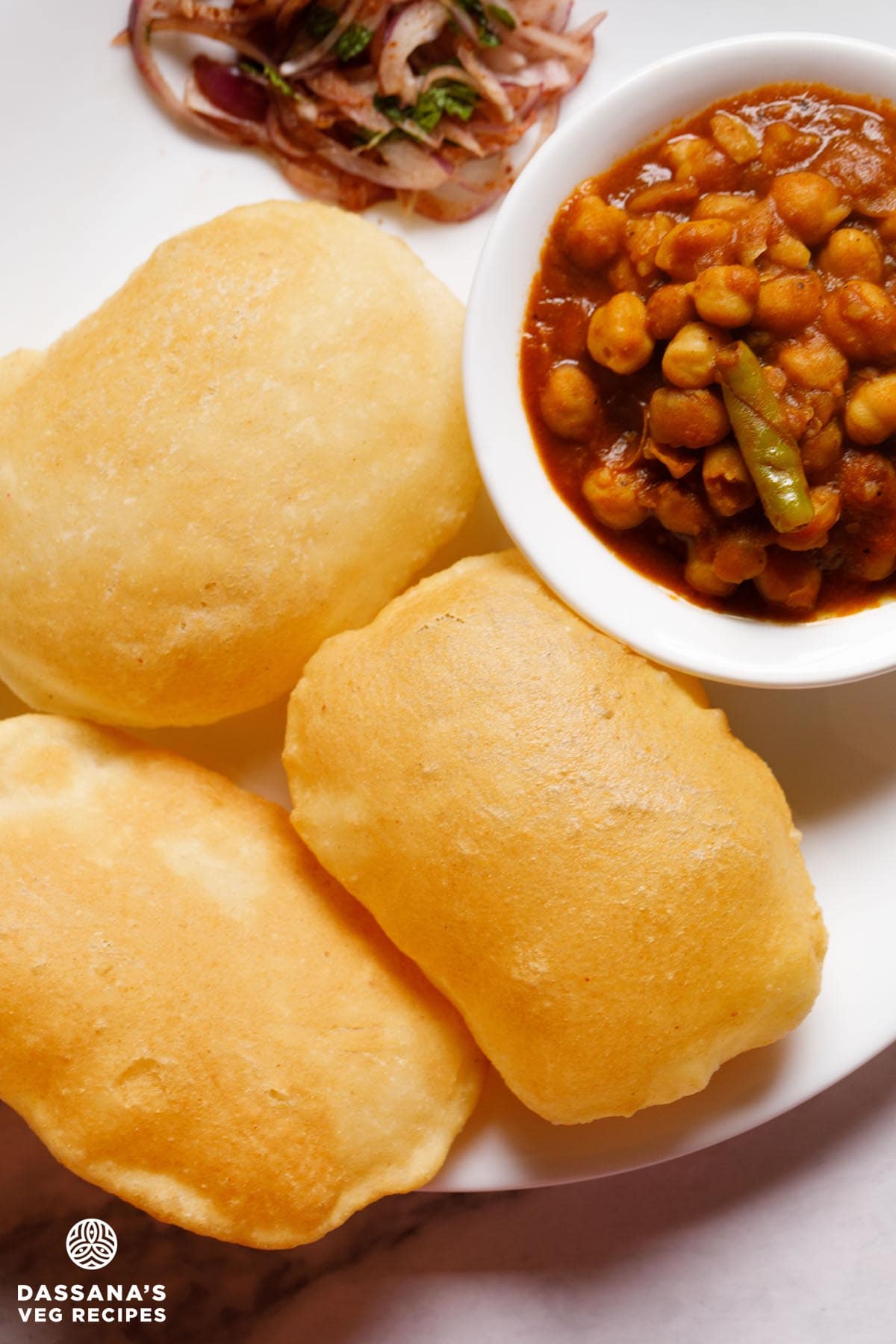
Bhatura is traditionally made with all-purpose flour. To make it crispy, some suji/rava (cream of wheat) is added together with yogurt for a slightly sour taste.
To achieve the signature puffiness of Bhature, a leavening agent is always used. This can be a natural fermenting agent like a sourdough starter, yeast or an instant rising agent such as baking soda or baking powder or fruit salt (eno) and even drinking soda (sparkling water).
Table of Contents
In this post, I’m sharing a quick and easy method for making Bhatura without yeast. This instant recipe uses baking soda and baking powder to help the dough rise, along with yogurt for fermentation.
The dough requires just 2 hours to leaven, making the process much faster. The reaction between the baking soda, baking powder and yogurt (curd) results in a fried bread that is light, soft and beautifully puffed.
This recipe yields soft, fluffy, and flavorful bhature without any overly sour taste. The dough needs only 30 to 45 minutes of resting time, but you can leave it for 1 to 2 hours if you prefer a bit more leavening.
Once rested, roll and deep-fry the bhature while you prepare your favorite chickpea curry to serve with it.
The Bhatura is made with all-purpose flour (maida) and fine semolina (sooji or rava). I have also tried substituting semolina with rice flour, and both versions taste great. The rice flour variation remains softer even after cooling.
As mentioned earlier, baking soda, baking powder and yogurt serve as leavening agents. Adding both the baking soda and baking powder ensures that the bread does not have the typical soapy aroma which occurs if you only add baking soda and a metallic after-taste if you only add more of the baking powder.
Step-by-Step Bhatura Recipe
1. First sift the following ingredients in a mixing bowl:
- 1½ cups all-purpose flour (maida)
- ½ teaspoon salt
- ¼ teaspoon baking soda
- ½ teaspoon baking powder
Once the above ingredients are sieved, add 7 tablespoons rava or fine sooji (semolina) and 1 tablespoon sugar in the same bowl.
Mix these dry ingredients evenly with a spoon
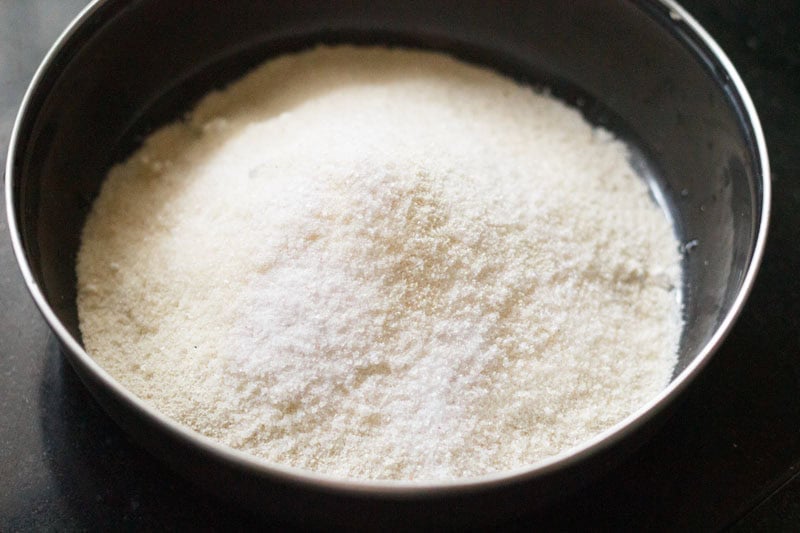
2. Add ½ cup yogurt (curd) and 2 tablespoons oil. Mix thoroughly with a spoon.
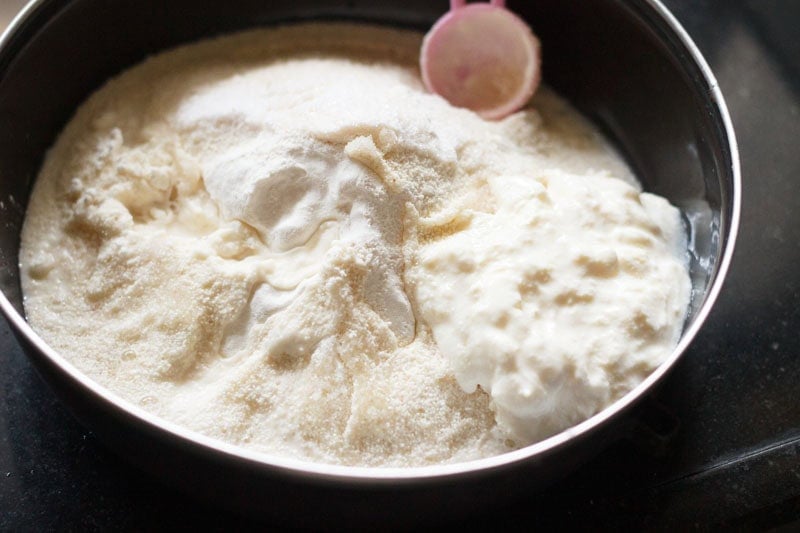
3. Add about ½ tablespoon water at a time. Mix and then knead to a smooth, supple and soft dough. Make sure the dough is not sticky.
You will need to add a total of 3 to 4 tablespoons water, or as required to get the right consistency and texture in the dough.
If it looks sticky, sprinkle a few tablespoons of flour and continue to knead. If the dough looks dry or floury, add little water and knead.
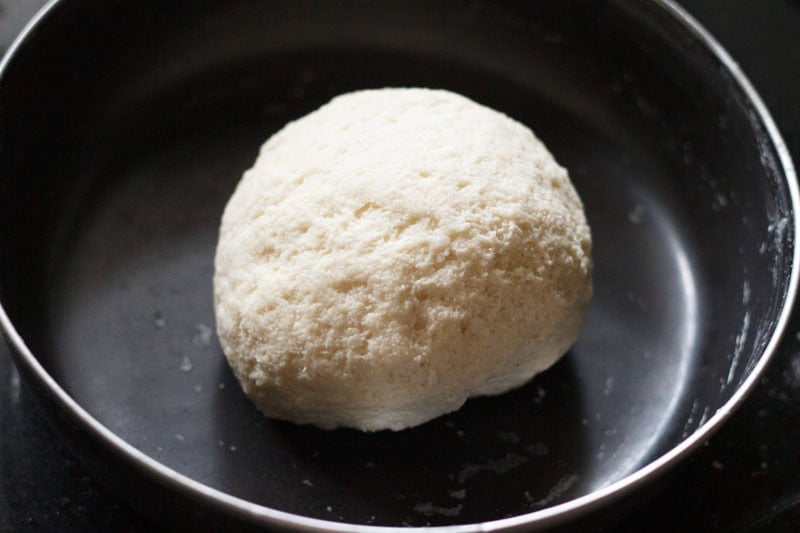
4. Cover the dough with a wet cotton napkin and set aside the dough to leaven for 30 to 45 minutes. You could even keep it for about 1 hour to 2 hours.
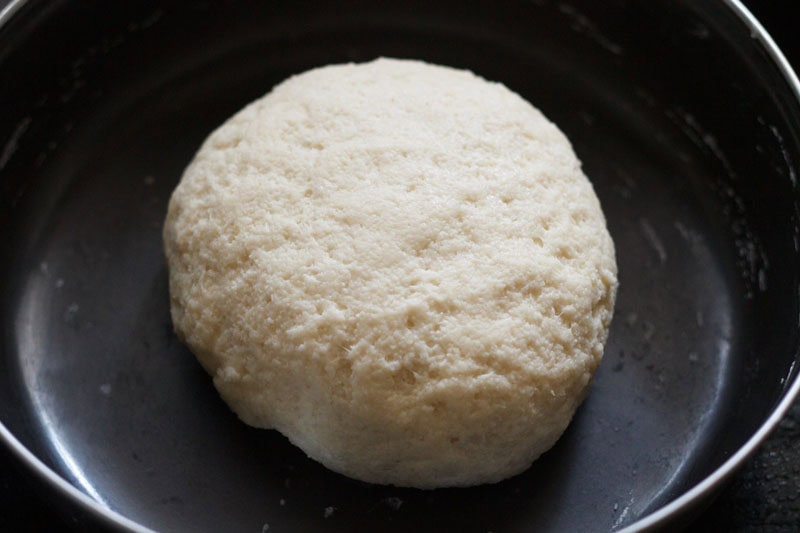
5. Before you begin rolling and frying, heat oil as needed for deep frying in a kadai (wok). Keep the heat to medium or medium-high.
Make medium-sized balls from the dough. Apply oil to the dough ball on both sides.
Using a rolling pin, roll into an oval or elongated shape ensuring that the edges are about 2 to 3 mm thick.
Remember to roll the dough evenly without making the edges thin. An unevenly rolled dough won’t puff up uniformly.
You could make either larger or medium-sized bhatura. If you choose to make larger bhature you will need to use bigger dough balls. However this will yield fewer bhature from the recipe.
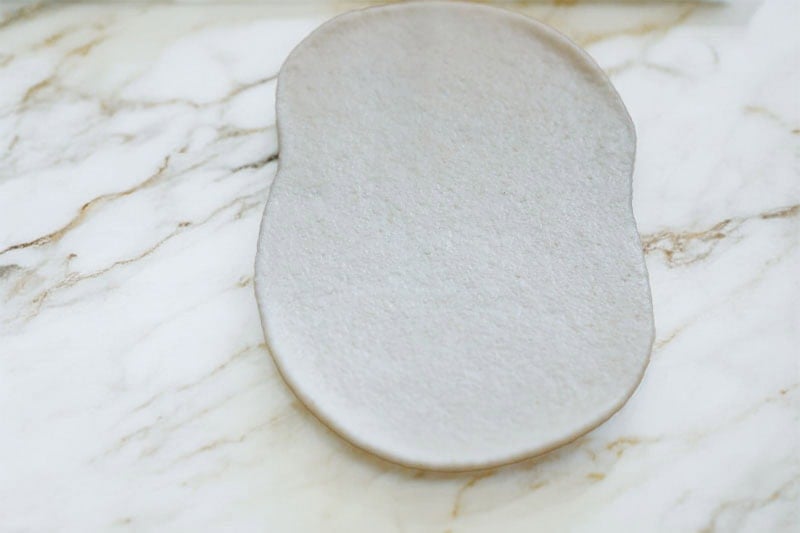
6. Drop the rolled dough in hot oil and it will start puffing within a minute. Fry on medium to medium-high heat.
Use a slotted spoon for frying and gently nudge the rolled dough to help it puff evenly.
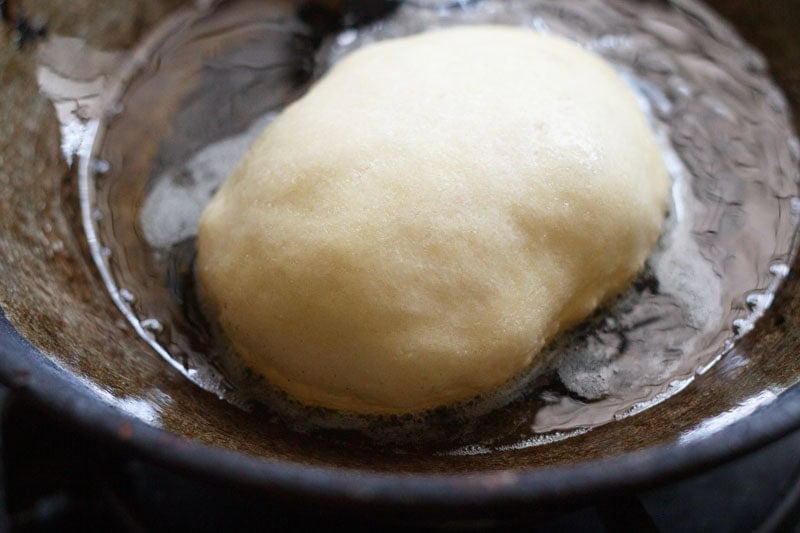
7. When the sizzling of the oil stops and the bhatura turns a light golden or golden, turn over and fry the other side.
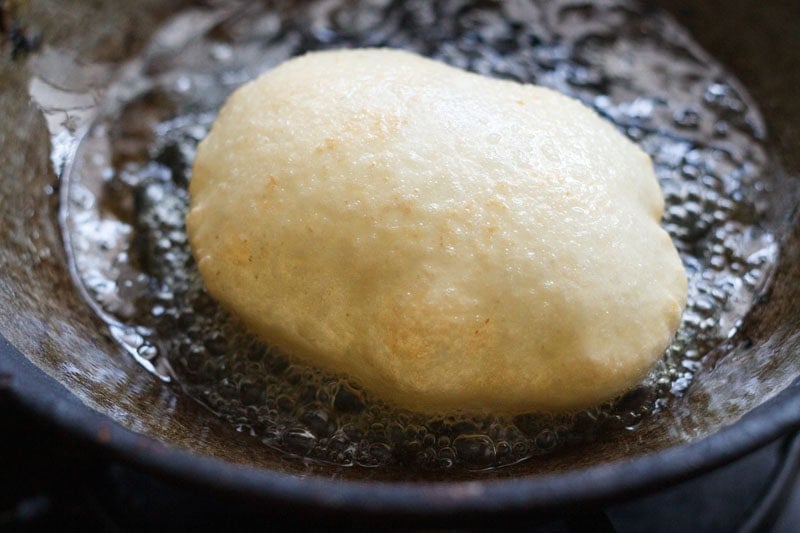
8. When the second side is light golden or golden using a slotted spoon remove the bhatura. Place it on paper towels to remove excess oil.
Fry all Bhature this way in batches.
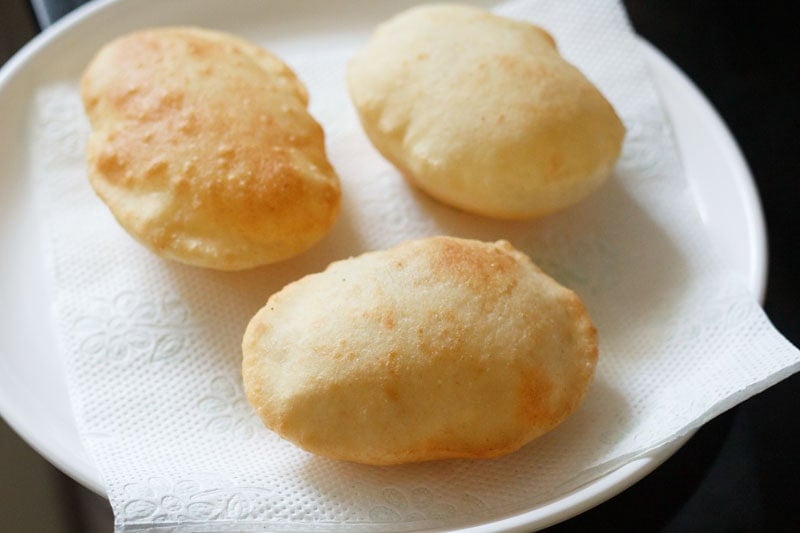
9. Serve Bhatura hot with Chana Masala or your favorite chickpea curry. Bhature tend to be chewy once cooled, so it is best to enjoy them while still hot.
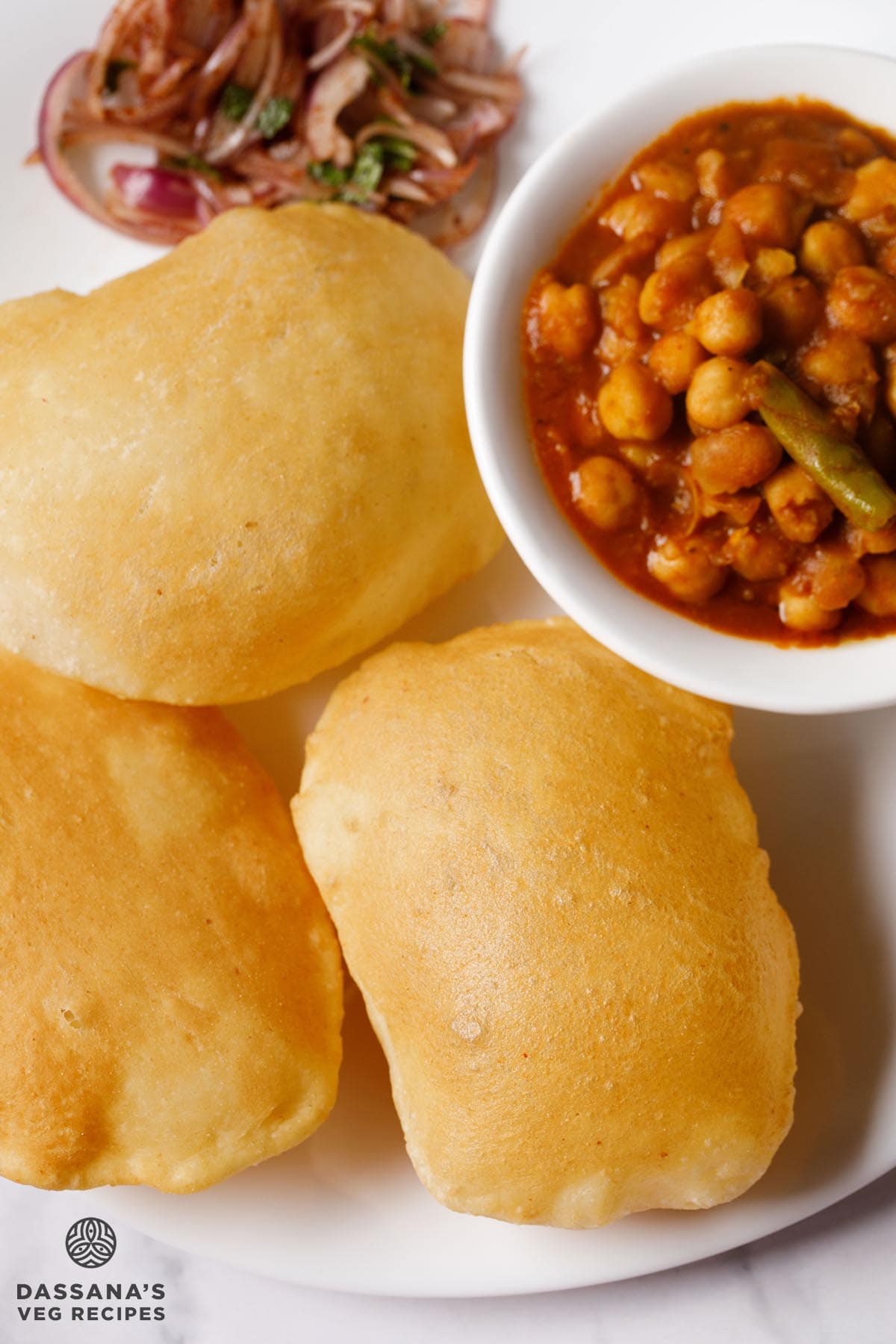
Expert Tips
- Using blend of flours: While all-purpose flour (maida) is traditionally used, adding a small portion of semolina (sooji) or rice flour can enhance the crispness while keeping the Bhatura soft inside.
- Adding sugar: Some sugar enhances fermentation and gives the Bhatura a slight golden color when fried. It also balances flavors subtly.
- Resting dough: To speed up fermentation, keep the dough in a warm spot (like inside a microwave or oven with the light on). This helps the baking soda and curd react better, making the Bhatura airy and fluffy.
- Rolling Bhatura: When rolling, don’t apply too much pressure – gently roll to maintain air pockets. This helps the Bhatura puff up evenly when fried.
- Frying Bhature: The oil should be medium-hot. If the oil is too hot, the Bhatura will brown quickly but remain raw inside; if too cold, they will absorb too much oil and turn greasy.
- Additional flavors: Since Bhature is deep-fried, adding ¼ teaspoon ajwain (carom seeds) or crushed fennel seeds makes them easier to digest while enhancing flavor.
FAQs
What to do if the Bhatura dough is sticky?
If the dough is too sticky, sprinkle a little more all-purpose flour (maida) and knead again until it becomes smooth and soft. However, avoid adding too much flour, as it can make the Bhature dense. Lightly greasing your hands with oil while kneading can also help handle sticky dough.
Can I use baking powder instead of baking soda in the dough?
While technically you can substitute baking soda with baking powder, but you’ll need add to 3 times more, which is a total of 1¼ teaspoon in this recipe. This much quantity of baking powder, may result in a metallic after taste which is not pleasant.
What is the difference between baking soda and baking powder?
Baking soda (sodium bicarbonate) is a pure alkaline substance that needs an acidic ingredient (like yogurt or lemon juice) to activate it and produce gas for leavening.
Baking powder includes baking soda together with an acidic component, so it can work on its own without additional acids. It provides a slower, more controlled rise compared to baking soda.
Why is yogurt (curd) used in Bhatura?
Yogurt acts as a natural leavening agent, working with baking soda to leaven the dough, making the Bhature light, soft and puffy. It also adds a slight tangy flavor and helps improve the texture, preventing the bhature from becoming too chewy or dense.
Step by Step Photo Guide Above
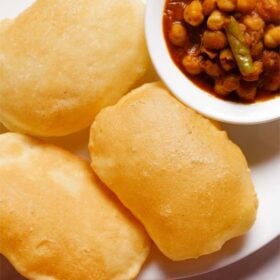
Bhatura Recipe (Quick Bhature)
Ingredients
- 1½ cups all-purpose flour (maida)
- ½ teaspoon salt or add according to taste
- ½ teaspoon baking powder
- ¼ teaspoon baking soda
- 7 tablespoons sooji rava/semolina – fine textured and not coarse
- 1 tablespoon sugar – fine or super fine
- 2 tablespoons oil or ghee
- ½ cup Curd (yogurt or dahi)
- 3 to 4 tablespoons water – for kneading or add as required
- oil – for deep frying, add as required
Instructions
Making Bhatura Dough
- Sift the all-purpose flour with baking powder, baking soda and salt in a mixing bowl.
- Add the sooji and sugar. Mix thoroughly.
- Add the yogurt, oil and mix again with a spoon
- Add very little water bit by bit (just about ½ tablespoon at a time) and begin to knead.
- Knead the dough, adding water as needed.
- Form into a smooth, supple and soft dough.
- Cover the dough with a moist cotton napkin and let the dough leaven for 30 to 45 minutes at room temperature.
Making Bhatura
- Heat oil in a kadai or pan for deep frying.
- Make medium-sized balls from the dough.
- Roll the balls between your palms to make them even.
- Keep the balls covered with the damp kitchen napkin.
- Take a ball and flatten them slightly. Apply oil on both sides and with a rolling pin, roll the ball into oval or elongated shape making sure the edges are about 2 to 3 mm thick.
- Make neither thick nor thin bhature.
- Rotate the rolling board while rolling the bhature as it much easier than lifting it, since we are not using flour to roll them.
- When the oil is hot enough, place the rolled dough gently into the oil. It will puff up.
- Aid in puffing by applying light pressure on it with a slotted spoon.
- When the oil stops sizzling and the bhatura turns light golden, turn oven and fry the second side.
- When light golden, remove and drain on kitchen paper towels to remove excess oil.
- Make the rest of the bhature this way. Serve the bhatura hot with chana masala.
Notes
- Ensure to use suji (rava) as it helps to get a slightly crispy texture.
- Additionally make sure to use both the baking soda and baking powder in combination.
- The dough can be rested for about 30 to 45 minutes or up to 2 hours. Keep it covered with a moist damp cloth to prevent drying.
- The oil should be moderately hot, but not smoking hot. If the oil is too hot, the bhatura will brown quickly but will be undercooked inside. If the oil is cold or warm, the bhature will absorb more oil.
- Fry the bhatura one at a time, so that it puffs up evenly.
- You could add ½ cup rice flour instead of rava or sooji.
- The nutrition information is for 1 bhatura.
Nutrition
Bhatura recipe from the archives was first published on April 2013.

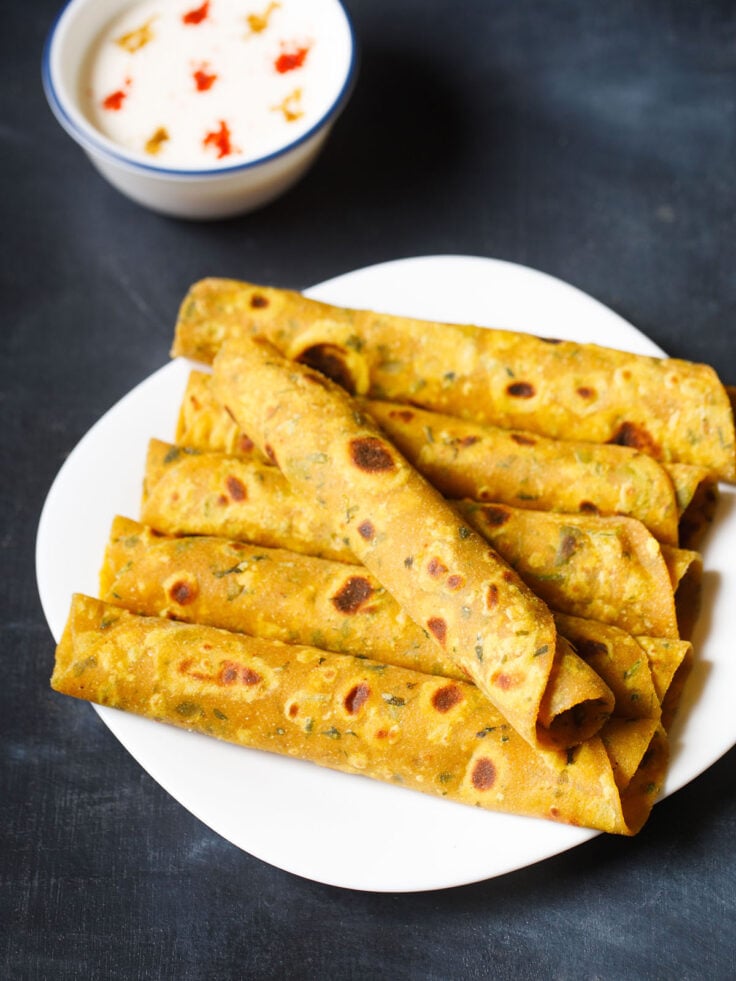
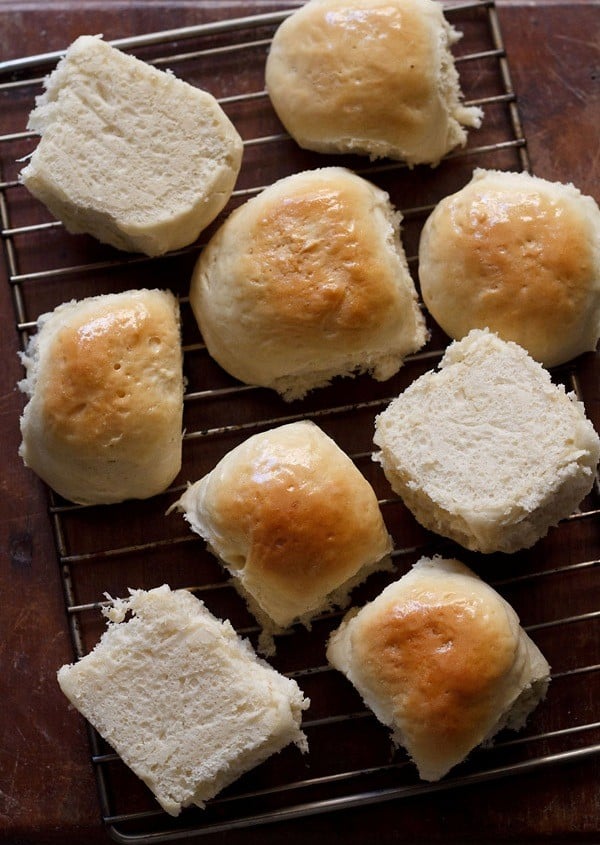
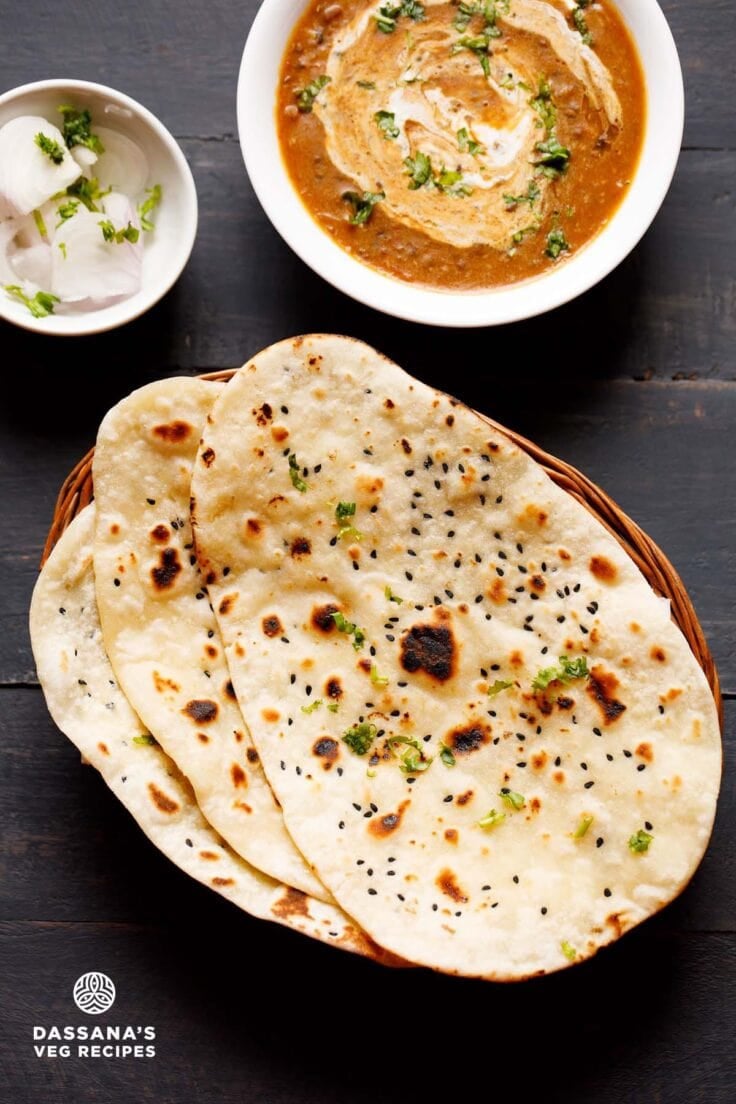
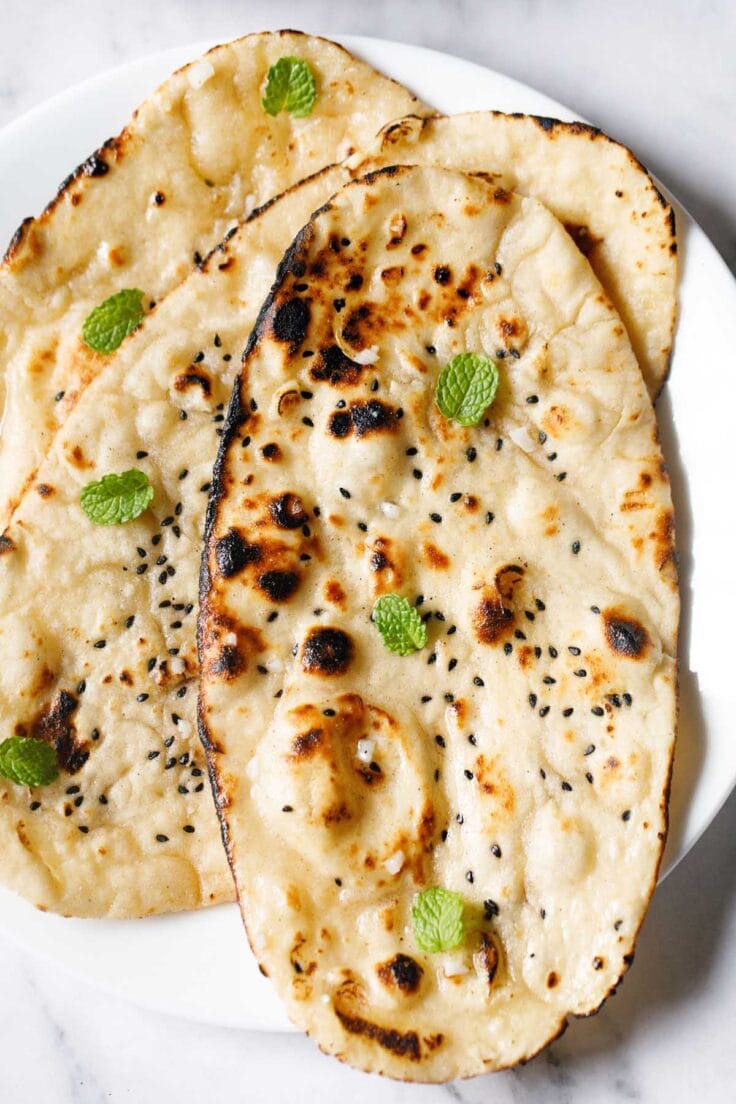
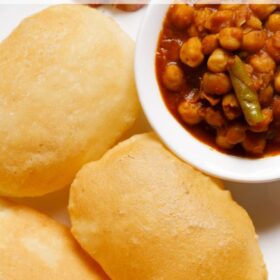
Hi Ma’am,
Can you please share thr overnight whole wheat bhatura recipe. Its the best and tastiest bhatura recipe that I have ever come across.
Love the recipes you put.
Regards
Thank you Sneha for the lovely feedback. Have taken a note of your email and will send you the recipe in a few days.
Hi Dassana, thank you for sharing all the wonderful recipes and with such details. I too would like to get your recipe for whole wheat bhatura. Thank you.
Hi Sabiha, thank you for the lovely feedback on the recipes. I will send the recipe to you by email shortly.
Hello Dassana,
Could you please share the whole wheat bhatura recipe.
I have been making whole wheat bread and cakes using your recipes, would like to make whole wheat bhatura also.
Many thanks.
Hi Rahul, thank you so much. I am really glad to know you’ve been trying the whole wheat bread and cake recipes.
I’d be happy to share the whole wheat bhatura recipe with you. Could you please confirm your email so I can send it across?
Received your email and I have send the recipe to you.
Love your recipe Dassana!
Been using it for a few years now. I was surprised that it looked different this time – only to read the comments and see that you have actually made some changes. I’d love to receive the other versions please: the wholewheat one and the overnight fermented one. It was nice having all versions available but I can understand the motivation to simplify.
Blessings,
Maha
Thank you so much for your kind words and continued support. It truly means a lot!
Yes, I recently updated the post to make it simpler, but I’d be happy to share the older version with you. I’ll send both the overnight fermented recipe to your email shortly.
Blessings to you too!
Hi Dassana,
Can you send me the wholewheat overnight fermented bhatura recipe, please. Its the best and a healthier version. I have been making that for years.
Hi Barita, glad to hear that. I’ll send the recipe to you by email shortly. Thanks for the kind words.
Makes for yum bhaturas without any hassle! What a star recipe! 🙂
Thank you so much. Glad you loved it. Happy to hear the bhatura turned out great and hassle-free.
Hi Dassana,
Could you please send me the whole wheat bhatura recipe? We really liked that recipe as it was a healthy version.
Many thanks
Hi Deepali, thank you for your lovely comment. I am glad to hear you enjoyed the whole wheat bhatura recipe. I will send the recipe to the email address you’ve provided in the comment form within the next few days.
Hi, Love your recipes always. I learned cooking from your recipes and everything turns out yummy. could you please share the recipe which included overnight fermentation process? It was a healthier recipe. Thank you.
Hi, thank you so much for your kind words. I’m really glad to know the recipes have helped you in your cooking journey!
Regarding the overnight fermented wheat bhatura recipe — if your email address is correct, I’ll be happy to send it to you in a few days.
Hi, I remembered seeing Bhatura recipe made of whole wheat. Is it possible to get that recipe. Have enjoyed trying most of your recipes. Every time it turned out to be perfect. Thank you
Thank you so much for your kind words! I’m glad the recipes have turned out perfectly for you. Could you kindly confirm your email address so I can send the recipe to you.
Can you send me the whole wheat bhatura recipe. Thank you once again.
Hi Aparna, thanks for the confirmation. I will send you the recipe soon.
This bhatura recipe came out very well.
Many thanks.
Glad and thank you for the feedback. Most welcome!
Hi dear, I’ve been referring to your website for years. You had a bhatura recipe which used atta instead of all purpose flour. But you used maida with curd and baking soda/powder for an overnight starter. The recipe seems to have been removed.
Please share it here, it was a good alternative to using maida and gave good fluffy results.
Hi, thank you so much for your kind words and long-time support! I decided to remove that version to simplify things. Including multiple detailed methods in a single post can sometimes overwhelm readers, so I wanted to make the post easier to follow by streamlining the content.
If you’d like, I’ll be happy to share that particular recipe with you – just kindly confirm your email, and I’ll send it over.
Mam thank you for making our life easy by sharing wonderful recipes.I am unable to find the bhatura recipe which you have posted earlier where the fermentation starts overnight. The next day wheat flour has to be added. Can you please share that again ?
Thank you Seema, for your kind words. I had removed that version of the bhatura recipe to avoid confusion, as having multiple elaborate methods in one post can be overwhelming for some readers. If you’ve entered the correct email in the form, I’ll be happy to send the recipe to you directly. Please feel free to confirm here as well if you’d like.
Mam, thank you for your quick response appreciate it. Please share that recipe on my email id that’s the correct one. I find that bhature recipe fool proof and a very convenient one. I don’t have words to tell you how it has become a part of my life. Thank you ma’am.
Hi Seema, thanks for confirming. I will send you the recipe on your email. And thanks so much.
Thanks for the recipe!!
It came out to be awesome.
Wonderful recipe with easy explanation about the ingredients used.
Thank you.
Great recipe, thank you turned out very tasty and good
Wonderful and thanks for letting me know. Thanks for the rating too.
Would you please move next door to me, and, can I come over for dinner a few nights a week?
Thanks Joan for this sweet comment.
Thanks for the recipe Dassana. This is my go to website for all veg recipes. It free from unnecessary ingredients and have a home made taste to it. Keep it up.
Thanks Farhat for your positive feedback.
Awesome it turned out…..I have never made such beautiful bhaturas in life … thank you
Welcome Anjana. Glad to know that Bhatura turned out well.
Hi Dassana! It’s been long since I wanted to thank you for sharing such wonderful recipes.
I am following since last year and trust me my cooking is enhanced. Whether it is banana muffins or daal makhani for examples….the dishes came out so delicious.
I must tell you that I tried smoke trick with mixed panchmel daal as well and it was par expectations at home by all.
My next try is definitely bhatura and then malai kofta.
I love your recipes because ingredients are always available at home.
Thanks a ton again and always!
Welcome Prachi. Glad to know that recipes are helping you in cooking tasty dishes at home. Loved reading your positive comment. Happy cooking.
I made it today and it turned out so well. Husband loved it. He is a typical North Indian Chana Bhature fan so am really glad he enjoyed it. Thank you so much for the recipe.
Welcome Jyoti. Glad to know this. Do try some more recipes.
hi dassana..made yesterday. but my bhatura came out crisp rather than soft n chewy.
farah, wondering what must have gone wrong. i guess either the dough was not kneaded well and this must have made the bhatura chewy. or could be the baking soda is the culprit. it should be fresh and not near expiry. also fry in hot oil. if the oil temperature is low, then the bahtura does not puff up. they become crisp. i hope next time when you try the recipe, it comes out well.
Hello,
Love you website. Thanks to you I can cook Indian food for my husband . Is it possible to stuff these bhaturas with paneer?
Welcome Vanessa. Yes you can.
I have tried mostly all the receipes.they are truly lovely.it does nt get anywhere wrong. Just love it…..thank u for making life simpler dassanna
welcome meryl. glad to know that i could help.
I tried this receipe n it came out very tasty. All my friends loved it. Thanks a lot
thanks lavita for sharing your feedback on the bhatura recipe.
You made my Diwali great, I made the bhatura. It was very good.
thanks for the feedback manoj.
Thanks for the help ….. I love to make this
sure thanks arti.
Hi,
This recipe is amazing. My kids always demand bhatura for weekends and my whole family loves it.
God bless…
Jasmin jamshir
pleased to know this jasmin thanks for positive views 🙂 god bless you too.
yummy…
Nice and very tasty recipe. My kids really loved it.
thankyou jasmin 🙂
hii 🙂
i usually try most of your recipes and i must say they r truly amazing!!
thanks for the wonderful recipes!!
while checking for the bhatura recipe i saw the same recipe, which u mentioned above , in an other site .. do you have an other site too? or did that person copy paste your recipe…
thanks a lot. i do not have any other website. the other site must have copy pasted the recipe. let me know which website this is.
Hi dear…thousands of thanks to u for Ur dishes. As the way u r giving this all step by step, it’s very easy to understand. I have tried some of it n my husband n my in laws literally got impressed. Thank u so much.
welcome supriya glad to know this and thankyou so much 🙂
Hello, Thanks for sharing your bhatura recipe. I have several others but this one came out just perfect. This was the one I can refer always now. Thanks again.
pleased to know this sapna 🙂 and you are always welcome.
Hi dassana.wonderful recipe.but is it compulsory to add baking powder in the white flour. Only curd and white flour won’t work.
thanks pooja. the baking powder will help in leavening the dough. so its required.
Hi… I had tried few recipe and it was really very good. thank you
welcome premalatha
Hi, happy holi. I decided to make chola bhatura, hummus and falafel – all from your blissful site. Everything turned out soo good. Though I had to make falafel again today; as I made them last night n my bowl in which I put uncooked falafel accidentally fell down and broke. But today everything went all well, touchwood. Thanks for making our sumptuous holi.
happy holi pooja. good to know. small mishaps happen when cooking 🙂 we also had a nice holi 🙂
Love your chole and bhature recipe.Cant wait to make them.Thanks
welcome indira
Good!
Is the dough supposed to rise when left for 2 hours in the morning?
yes, the dough will rise. in colder temperatures, it may taker longer though.
excellent mouth-watering recipes. would wish to be emailed of same often.
thanks.
thanks napaul. you can subscribe to facebook for updates.
Hi Dassana amit, I tried ur bhatura recipe as per ur instructions. It comes out awesome. I wondered about the perfect puffing and texture. While puffing the bhatura really I felt very happy that my effort and ingredients didn’t go waste. So the full credit is goes to Dassana. And now am confident to fallow ur style of cooking. And the important thing ur step by step photos and instructions induce me to do the bhatura with confident. Please post recipe with step by step photos, instructions and notes. Thank You…
thanks a lot gayathri for the feedback. glad to know. the new recipes, 99% of them are step by step posts. will surely add more posts too.
feeling confident to try out this….. nicely narrated……inspired by the pictures..looks sooo yummmy
thanks
welcome chytali
A good method. East to follow. Excellent taste.
thanks bagirathi
Tried the recipe, did not turned out exactly the same
Made with maida only…. The bhatura’s used to puff and collapse….
by puffing and collapsing, you mean in the oil or outside. if you keep the bhatura as an individual piece, it will be puffed up. but if you keep other bhaturas on top, it will collapse.
hi di I made bathure with chanas today …they are sooooi yummy…..thanks for recipe
welcome prabh. glad to know this.
Hi, just wanted to confirm if maida is also called white flour?
garima, you are right. maida is also called as white flour.
If I need to make this with full white flour instead of atta do I need to change the measurement of curd, baking powder, etc
no need veena. but in case if the dough becomes too moist, then just add a little extra flour while kneading and it will be fine.
wow I love this recipe. thanks for sharing
welcome jas
Hi just want to check that in case I wish to refrigerate excess dough will the bhaturas turn out as well the next day? Or can I leave the dough at room temp? TIA
yes they will turn out good the next day. but just keep for one day only. don’t keep at room temperature. keep in the fridge.
i love it as brunch. thank u for recipe and whole method.
welcome sukhlal
Such a detailed writeup….thank you so much…am so confident after making bhatura following this recipe….they turned out so soft and each one puffed up…and most of all so little oil was used …excellent recipe
thanks sital for this positive feedback
Hi Dassana…
Trying this method for the first time… Just to confirm did u mean Baking soda or should i use baking powder? Please advise. Thanks a lot.
actually i have used both and made these bhaturas. however, with baking soda there will be its slight aroma. so i suggest adding baking powder.
hey this diwali i am thinking of making bhature for the first time. though i liked your recipe, the only thing i want to know is will they taste as good as the one made with maida?
they taste equally good since the recipe method is different.
thanks a ton.tried ur recipe and it was fantabulous.
thanks swati, glad to know that bhatura recipe came out very well for you.
Dassana,
This recipe rocks, girl !! My boyfriend’s mother is from India and she visited us last week. She’s an awsome cook, and I was really worried how she’d like eating at our place. This ‘Bhatura’ recipe really saved my life ! She was very impressed !!
Thanks a million!
wow….. thats so nice to know kris. thanks for the feedback and am glad to know the bhatura recipe helped you a lot.
Hello Dassana,
I have tried this recipe many times now and it has been fool proof every time. Thanks for bringing this beautiful recipes to us.
Take care
thanks for this positive feedback. i am sure it will inspire few more readers to try this bhatura recipe.
The Bhatura recipe was excellent. Thanks Dassana, whoever you are. Thanks for sharing you’re recipe so accurately. Many people don’t give the correct recipe. They leave out some ingredient or other. You’re recipe was perfect and it came out very very well. I used more whole wheat atta 2:1. Thanks once again for sharing. Thanks to this website ‘vegrecipesofindia’ too.
thanks a ton asha for your feedback and positive comments.
mine bhatura become very thick ,many didn’t puff up .it used to break while frying.pls give some tip
frying bhatura is exactly like frying puri. something must have gone wrong in the kneading process or in the water – flour ratio. hence the bahturas did not puff up.
pls let me know which oil did u use? refind or musturd?
thanks
shreya
i have used rice bran oil. you can also use sunflower or safflower oil. avoid using mustard oil.
thank u very much for the awesome recipe.
thnx we found ur recipie very convinient
I believe that there is no need of adding baking soda. As, we are already adding curd which is more then enough. If we are not putting the dough for a long time then we can add the baking soda. A sin this case as we are already keeping the dough for around 8hrs, its not required. Baking soda changes the taste of the food. So avoid using it if you enough preparation time.
hi amit, since this recipe is adapted from a book, i kept the ingredients as it is and it works for me when i make these bhaturas. the idea of adding baking powder or soda is that it helps in leavening of the flour and makes the dough light and fluffy. baking soda does have a soapy taste, so baking powder can be added instead.
Aapki recipe ka tarika bot acha hota ha ma hameha follwo karti hu bhatura recipe bhi try ki thi very nice god bless you thanks.
thanks mina
hello, i tried and it came out very well. thanks a ton for posting this recipe. useful work ever.
thanks
Hi Dassana,
I have a small doubt, my understanding is mixing of wheat flour and sugar has to be done in morning NOT in the night when “white flour and yoghurt” mixing is done.
the sugar, white flour, yogurt and baking powder have to be mixed in the night. this mixture is allowed to ferment for 8 hours. then this mixture is added to the whole wheat flour and oil mixture.
i live in australia and dont know how to make all that stuff please suggest some simple ideas thanx =D
Use 2 teaspoon of yeast with half teaspoon of sugar and ¾ cup of lukewarm water for 15 minutes and then mix that to the dough, if you do not have yogurt and time to ferment the dough !
thanks for this tip.
Perfect recipe…made it and enjoyed it too…Thank you for exploring and posting the recipe Dassana
thank u ……….
now i can eat batura at home with happily…………………….
yummy and tasty
i surfed a lot for the recipe.. Stumbled upon many.. And this one.. It was perfect.. Tried it and fell in love with it.. Crispy n soft too.. Tnx a lot!
hey zahira. thanks 🙂
I agree with suhani the yogurt measurement seems to be off maybe because it is store bought yogurt as is yogurt in US is more thicker than India I am making it now will definitely update the results later
dear shirin, the yogurt measurement is what i have used as mentioned in the cookbook from where i have adapted the recipe…sure do update me.
hi Dassana i made bhaturas again few days back and this time they turned out very nice and tasty..i paired them up with pindi chole..and we had a wholesome dinner..again thanks for ur guidance..
thanks suhani… long time i have not made chole nor bhaturas at home…. plan to make these bhaturas soon.
Hi im setayesh a female from iran.i visited your website and enjoyed.i decieded to translate your recipes by keeping your name if you please.
dear setayesh, it is alright. as long as you give the link to the original content on my blog, i am alright with it.
thanks dassana.
I tried your recipe after googling many others… your awesome pics and use of whole wheat atta encouraged me to try it.. And it was fantastic.. Loved every bit of it and also the texture was fabulous, thaaaaaaanx a lot
thanks shilpa. comments like yours encourage and motivate me to share more recipes.
I tried the recipe n it turned out to be the awesome.Thanks.
welcome rama
yes now i understood why my bhaturas were not good anyways i will add more yogurt to the mixture next time..thanks Dassana
hey dassana..this bhatura recipe is the original recipe with a natural fermentation..i liked it very much however the results were not good for me..firstly when i made the white flour mixture it was not a paste consistency as it can be seen in ur pics..it was a dough like consistency anyhow i added warm milk to it for giving it the correct paste form..the next day i made the dough with wheat flour as per ur recipe..now when i was deep frying they didnt easily puffed up like urs..where did i go wrong..may be u can help me out.. i dont want it to happen next time..plz help me
i think the addition of milk has made affected the leavening process. i am unsure why you did not get a paste like consistency. instead of adding milk, you could have just added some more yogurt. that would have helped the bhaturas to ferment well.
Turned out marvellous. Tks to you again…….
Btw do you have recipes for arabic dishes like zattar and cheese fatayar
Tks
thanks deepa. the bhatura is a tried and tested recipe and has always worked for me.
i do not have arabic dishes like zattar and cheese fatayar. i know of zattar but cheese fatayar i will have to find out.
Thanks for your response. Does not matter… Actually , I am at present in Doha, State of Qatar and will be moving back to India by end of next month. We are so very used to the arabic dishes for the past 15 years and will miss them back home. Hence was enquiring eagerly. Tks for all your guidance.
you may get the arabic spice blends and other edibles if you stay in the metro cities. but if you are going to stay in the towns or villages of india, then you might end up making them at home like me 🙂
Hi Dassana
Have made the dough today. Just waiting to see the results..will let u know soon. Recipe looks yummy !
awessome, any easy way of telling recipe, thanks.
thanks monika.
Tried this recipe and it was a grand success. Thanks for the recipe.
thats nice to know suja.
oh dassana you are simply superb sweetheart, the bathuras looks simply delicious, i never knew that this need to be fermented a night before, thankx once again.
thanks neela. do try this bhatura recipe. its too good.
Came out really well. Thank you for the detailed description.
thanks preetha. nice to know that the bhaturas were good.
Please inform if Bhatura came out dry and not oily
dear poornima, the oil should be moderately hot for frying the bhaturas. if it is warm then the bhaturas will soak up the oil and become oily.
This way of preparation looks amazing.Tomorow I am going to prepare in this way. Tomorow is a occasin of son’s birthday. I am going to celebrate with Chole & this bhature.
thats great vjay. do let me know how the bhature turned out.
Dear frnd..
I am going to prepare Bhatura…thank you for the recipe
Asha
hey asha, do let me know how they turned out.
Success!! Thank you Dassana for this wonderful recipe:-)
welcome asha…..
these recipies are just amazing …..the best thing is that u can see the pis of the dishes too……great
Have eaten bhaturas outside but never prepared by self. But your demonstration makes me eager to prepare it at home. m going to prepare it tomorrow… n yes m dead sure ( in advance) that its gonna taste fabulous. THANK YOU.
thanks bandhana
Hey.. Thanks a lot for the recipe and its narration. I will surely try this today.. 🙂
Well, There is another way of making bhatura, instantly and just like road side vendors in India. Bhatura will be very thin and and instant.
Just take proper measurement of Maida (flour), Paneer (200 grams for ½ Kg maida), 100 gram dahi or yogurt or curd, pinch of salt, and make the dough with club soda. Keep it aside for 1 hour before you use.
Check it out and it will be just like Indian road side bhatura.
You can also wash rings of raw onions with remaining club soda and it will take the onions smells off (atleast 50%, it not 100%)
thanks sanj for this quick recipe of bhatura. it will help all the readers.
thanks also for the tip on getting rid of the smell of sliced raw onions.
ek number banaya hai
I am a Bhatura fan! I have tried many variety of bhaturas, but this is really amazing and so nice. The recipie and narration are so outstanding. Thank you very much.
wonderful
thanks for you seema ji
Delicious & Mouth-watering!!!
its really nice to have such a easy and good receipe for making bhaturas. I used to think how to find way to make bhatura and also keeping in mind the health point. My whole family is fond of chole bhature.
Thanks for sharing this recipe with every one. I will surely try the same way
thanks shweta….. do try the bhatura recipe….
what is thatwhite flour?
white flour or refined wheat flour is maida in hindi…. the flour which is commonly used for making breads and cakes.
The bhatura recipe shown above is awesome. I tried and i try to show all my relastives and friends to make the bahtura’s the same way. Thanks for this one…it really worked for me.
thanks sonia….. this one is a tried and tested bhatura recipe for me and always worked for me. i am sure your friends and relatives will also have a nice time making the bhatura…
Seems a completely different way of making bhaturas. Will try this weekend.
do try this bhatura recipe. it is very good.
Awesome and yummy dish!!!!
thanks for this recipe.
Awesome recipe with great focus to details.
awesome and yummy recipe my fav dish